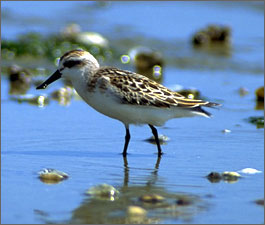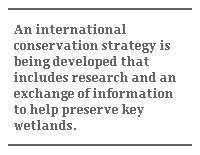Birds Trying to Fly South Face Many Roadblocks
Birds Trying to Fly South Face Many Roadblocks

MELBOURNE - Each year, more than two million migratory shorebirds fly to Australia and New Zealand to escape the winter that turns their breeding grounds in the northern hemisphere into a frozen wasteland. They spend their time in the South Pacific feeding on shellfish and worms along the seacoasts and wetlands and then return to their northern nesting grounds to rear their young when insects become abundant during the short summer season.
At least 36 species of waders make this annual odyssey of up to 25,000 kilometers, in one of the oldest examples of globalization. They include sandpipers, stints, godwits, knots, redshanks, snipes, plovers and curlews.

The shorebirds travel along flight paths that ornithologists call the East Asian-Australasian Flyway. They use routes similar to those of passenger and freight jets that, in recent decades, have played a key role in increasing commerce and drawing the world closer together. Of course, the shorebirds fly much slower than jets, at speeds of between 30 and 60 kilometers an hour depending on the wind; they also fly at lower altitudes of between 3,000 and 8,000 meters.
The flyway covers 20 countries in East Asia and the Pacific, extending from northern China, Mongolia, Siberia, and Alaska, where the birds nest, to Australia, New Zealand, and their offshore islands. Scientists estimate that the zone encompassed by this flyway supports over seven million shorebirds, of which some five million are migratory.
Yet just as modern jetliners depend on well equipped airports to refuel and replenish, migrating waders, too, need landing areas where they can feed and recover before continuing their journey. The birds use their stored fat as fuel. They renew their fat layer by feeding for two or three weeks. Indeed, officials and experts in the Asia-Pacific region say that the single greatest threat to the shorebirds is the loss or damage of these staging sites.

East Asia contains nearly half the world's population and many of its fastest growing economies. Amidst this rapid development, a lot of the 600 or so major estuaries, tidal mudflats, foreshores, and mangrove swamps used by itinerant shorebirds are being reclaimed for human use, mainly for homes, industry, agriculture and aquaculture. For example, although Singapore nearly a decade ago preserved 87 hectares of mangrove swamps for migrating shorebirds at the Sungei Buloh Wetlands Reserve in the northwest of the island-state, the government's Urban Redevelopment earlier this year gave notice that two nearby swamps used by the birds were to be redeveloped, probably as reservoirs. Singapore is short of fresh water and in dispute with neighboring Malaysia over the price it pays for importing water by pipeline. Economic globalization is taking its toll on birdlife.
The Yellow Sea, bordered by China and Korea, is a particularly vital staging area for shorebirds. Mark Barter, an Australian ornithologist who has spent several years studying migratory waders along the Yellow Sea concluded in a study for Australia's Department of the Environment and Wetlands International that although there were seemingly countless shorebirds in the Yellow Sea, their habitat was under serious threat.

"Unfortunately for the shorebirds, the wetlands they use around the Yellow Sea are very much reduced in area compared to 50 years ago and are continuing to be significantly threatened by ongoing reclamation, pollution, human disturbance and the insidious effects of reduced river flows," he wrote.
China and South Korea have reportedly reclaimed some 40 percent of their coastal and rivermouth mudflats. In East Asia as a whole, over half the significant wetlands are under serious threat of development, researchers say.
The South Korean government recently caused consternation among ornithologists when it announced that it would resume work on the largest reclamation project in the world - to turn the 400 square kilometer Saemankeum wetland on the Yellow Sea coast into a new zone for industrial development by 2006. Environmental groups took legal action and a South Korean court ordered a temporary halt to work on July 15. The Korean government has said it will appeal.
Ornithologists say that Saemankeum's two estuaries support large numbers of migrating birds, including eight globally threatened species. "Tidal mudflats in Korea, particularly Saemankeum, are vital for the survival of migratory birds in eastern Asia, " said Simba Chan, a specialist on Korean bird conservation and international coordinator of important Asian bird areas at BirdLife International, a global alliance of conservation organizations working in more than 100 countries.

Ornithologists say that what is happening along the East Asian-Australasian Flyway mirrors developments in the other seven major north-south shorebird flyways around the world, including those that traverse Africa, the Middle East, Europe, South and Central Asia and the Americas.
Since the international Convention on Wetlands was signed at Ramsar in Iran in 1971 to protect freshwater ecosystems and coastal and marine wetlands and ensure that they are managed sustainably, almost 10 percent of the world's estimated total wetland of 1,280 million hectares has been brought under its purview. Wetlands are crucial not just for birdlife but for flood control, water purification and food supply. Yet the WWF International, a wildlife conservation group, says that half the world's wetlands have been drained, filled and converted to other uses in the last century alone.
At least 128 bird species have vanished over the past 500 years, 103 of them since 1800, due mainly to habitat loss as human population mushroomed and industries, cities and international commerce ate into wilderness areas. Howard Youth, a birder and researcher for the Worldwatch Institute in Washington says that almost 1,200 species - about 12 percent of the world's 9,800 bird species - may face extinction in the next century.

Migratory shorebirds face many natural perils, among them storms, predators and food shortages. Habitat loss heightens such dangers and causes new ones. For example, tagging by scientists in Australia has indicated that in some conditions, including poor food supply, shorebirds heading north to breed turn back and instead return to their wintering grounds, missing a nesting cycle. Birds that do reach their breeding grounds in the northern hemisphere must be well fed and in good condition to breed successfully.
Barry Weeber, senior researcher at New Zealand's Royal Forest and Bird Protection Society in Wellington, describes the annual flight of migratory waders as one of the great wonders of the world. "It is amazing to think that birds so small can fly so far," he says. "Yet this annual flight is in jeopardy."
Weeber and other researchers say that reclamation projects in internationally significant coastal wetlands like Saemankeum in South Korea must be halted because such areas form vital links in a chain of staging points for the migrating shorebirds. "Birds tagged at the Firth of Thames here in New Zealand have been recorded in the Saemankeum wetland, including the kuaka or bar-tailed godwit," he says. "We know this wetland is important for New Zealand's migratory birds."

Australia has two bilateral agreements - with Japan and China - to protect migratory birds and their habitats. A third agreement is being negotiated with South Korea. With funding from the Australian government, an international conservation strategy is being developed for shorebirds in the East Asia-Australasian Flyway. It includes research and an exchange of information among governments and non-government organizations to encourage preservation of the wetlands that shorebirds use in their annual migratory flights.
More than 30 wetland sites - in Russia, Japan, China, South Korea, the Philippines, Singapore, Indonesia, Papua New Guinea, Australia and New Zealand - have been included in the staging network. But many ornithologists in the region fear that this may be a case of too little, too late, for the shorebirds.
Michael Richardson is a journalist who has worked for more than 30 years in the Asia-Pacific region.